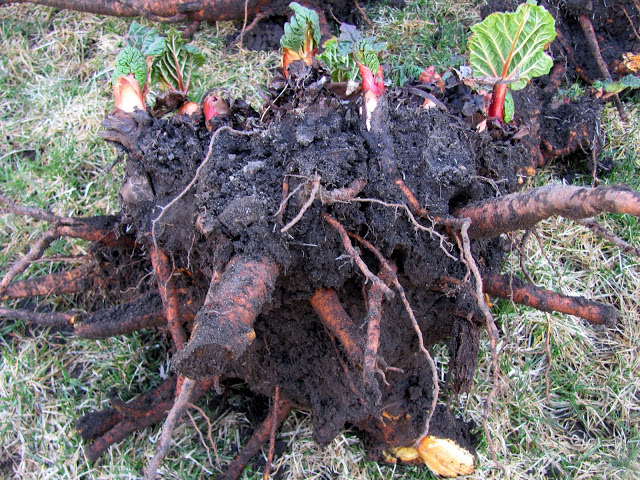Editor’s Note: This column first appeared on 2 May 2018.
What to do this week
This week is a good time to divide rhubarb, as well as a few other perennial plants, but rhubarb especially. If at all possible, you want to do it when you just see the tips of what look like buds starting to poke up from the soil. These are actually the leaves that are still folded as they push themselves up. It is better to be cutting and digging before the plant leafs out, so try to get out to the yard to check the timing of rhubarb in your particular garden. Hopefully, you will find these buds about an inch or so above the ground.

Rhubarb. (Source: My Minnesota Garden)
You don’t have to divide rhubarb every year. If your rhubarb was getting thin and spindly last year it means that the root has overgrown and is starting to strangle itself, so you need to dig the whole plant up and divide it into two or three pieces. Make sure that each piece has a couple of eyes on it. If you want more rhubarb than you had already, take each piece and put it into a new hole. Otherwise, the pieces could be given away. Dig each new hole at least two feet across, and work lots of compost into it. The rhubarb is going to be there for years, so you want to make sure you feed it well at the beginning.
Unfortunately, the rhubarb you dig up now will not produce enough stalks to harvest this year, so don’t divide all of your rhubarb at the same time. It will produce very well next year. I have about 12 big plants, so I dig up two or three of them each year.
If you are wondering where to plant the additional pieces, there are a few things to consider. Rhubarb likes rich soil. You don’t want it sitting in water, so it is best to avoid areas with very poor drainage, but it doesn’t mind heavy clay. Like anything people eat, rhubarb needs at least eight hours of sun a day, so deep shade wouldn’t be good either. The main thing is that it needs high fertility to keep producing.
One way to have the best of both worlds with rhubarb, if you really don’t have additional space to plant more, is to just cut out a chunk of it. That will give the remaining root some space to rejuvenate. Work in some compost around the plant to help it with that. You can give away the chunk you dug up, or just throw it away. Generally speaking, it is better to dig the plant up completely, but if you are stuck for time you could just do that. The remaining plant will thank you for it.
Now is a good time to do this kind of dividing with some other perennial plants. If you see some suckers coming up from your elderberries, or your currants, you can dig them up too. Get a good sharp spade for this sort of work. You should actually sharpen your spade with a little sanding block if you can. That will help a lot with this job.
Some things you don’t divide until later in the summer. Irises are a good example. Things you divide now include Chinese lanterns, perennial sunflowers, Jerusalem artichokes and daylilies. True lilies don’t get divided, but daylilies do. I like to focus on food gardening so I’ll mention that daylilies are edible, from root to flower.
Artichokes
In other news: we have a report on Madeline’s digging up of artichokes last fall. Artichokes are perennial in climates not quite as harsh as ours, and overwintering might be a way to get that increased production on the plant as it ages. She reported on this experiment here and here.
Three of the five roots jumped back to life in late winter, and are happily growing in the back porch. This year she also has new plants from seed, so it will be interesting to see if there really is better production on the overwintered roots compared to starting over. She will keep you up to date as the season develops. If you like artichokes, and want to follow her experiment, just remember that I chuckled at her a bit last year when I heard she potted the roots up for the basement. You could just as easily shake the roots clean and wrap them in burlap for their overwintering. Either way, experimenting is a good activity for gardeners.
Featured image: Early rhubarb (Source: My Minnesota Garden)
Market gardener, farmer, workshop leader, seed-saver, political candidate and mother, Michelle Smith has spent over 30 years coping with the challenges of our bioregion and in the process has built a store of practical and technical knowledge. The Inverness resident has served on the board of Seeds of Diversity Canada and represented Alternative Producers with the Federation of Agriculture but can do nothing about her hair. She is pictured with a head of Club Wheat, a seed that shares her approach to hairdressing.
Backyard food gardener Madeline Yakimchuk caught the food-security bug in the early ’90s through Cuba’s Urban Agriculture Department, taking her first permaculture course and planting her first garden. She can often be found discussing food security, nurturing a plant-based lifestyle or trying to give away vegetables. Professionally, she is GRYPHON media productions but sometimes uses la bruja in her volunteer work, most notably in managing the garden column, which begins life as a telephone interview.
[signoff]










